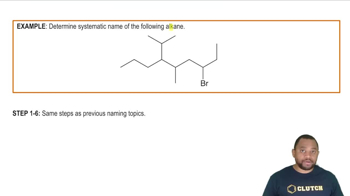Here are the essential concepts you must grasp in order to answer the question correctly.
Monosubstituted Benzene
Monosubstituted benzene refers to a benzene ring that has one substituent group attached to it. The presence of this substituent alters the chemical properties and reactivity of the benzene, allowing for a variety of derivatives. Common substituents include alkyl groups, halogens, and functional groups like -OH or -COOH, which can significantly influence the compound's behavior in chemical reactions.
Recommended video:
IUPAC Nomenclature
The International Union of Pure and Applied Chemistry (IUPAC) nomenclature provides a systematic method for naming chemical compounds. For monosubstituted benzenes, the substituent is named first, followed by 'benzene' to indicate the base structure. The position of the substituent is often indicated by a number, but in monosubstituted compounds, the position is typically implied as the first carbon in the ring.
Recommended video:
Substituent Effects
Substituent effects refer to how different groups attached to a benzene ring can influence its reactivity and stability. Electron-donating groups (EDGs) can increase the electron density of the ring, making it more reactive towards electrophiles, while electron-withdrawing groups (EWGs) can decrease reactivity. Understanding these effects is crucial for predicting the outcomes of chemical reactions involving substituted benzenes.
Recommended video:
Naming Other Substituents Example




